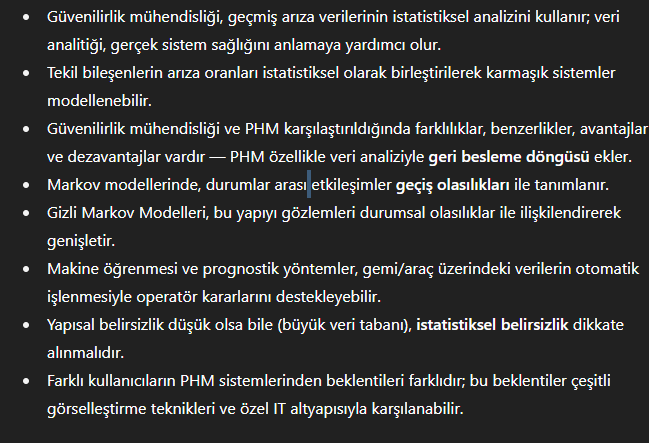L11 - Decision Making with Markov Models
1/19
There's no tags or description
Looks like no tags are added yet.
Name | Mastery | Learn | Test | Matching | Spaced |
|---|
No study sessions yet.
20 Terms
Reliability Engineering:
The discipline to develop methods and tools to evaluate and demonstrate the reliability, maintainability, availability, and safety of components, equipment, and systems.
Reliability Engineering: Field that develops methods/tools to check and prove reliability, maintainability, availability, and safety of systems.
Reliability:
Probability that the required function will be provided under given conditions for a given time interval.
Reliability: Probability that a system performs its required function under given conditions for a given time.
Safety:
Ability of the item to cause neither injury to persons, nor significant material damage or other unacceptable consequences.
Safety: Ability to avoid harm to people or significant material damage.
Reliability Engineering – Common failure distributions
Exponential distribution:
For constant failure rates (random failures, e.g., electronics).
Formula: F(t)=1−e−λt
λ = failure rate.
Weibull distribution:
Flexible, models different failure behaviors (matches parts of bathtub curve).
Reliability calculation for multiple components
Series configuration:
Example: Hydraulic circuit.
If one component fails → whole system fails.
Logical OR.
Example: Two components each with 0.90 reliability → System failure probability = 0.19.
Parallel configuration:
Example: Aircraft engines.
Redundancy improves reliability.
Logical AND.
Example: Two components each with 0.90 reliability → System failure probability = 0.01.

System reliability models (overview)
Reliability models combine component failure probabilities to estimate RAMS (Reliability, Availability, Maintainability, Safety).
Common models:
Part Count Method
Reliability Block Diagram
Fault Tree Analysis
Reliability Graph
Petri Nets
Markov Models/Processes
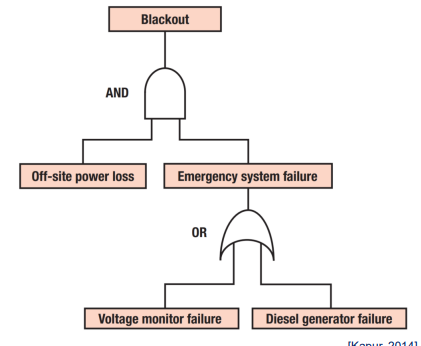
Fault Tree Analysis (FTA)
Tool for modeling failure dependencies in multi-component systems (tree structure).
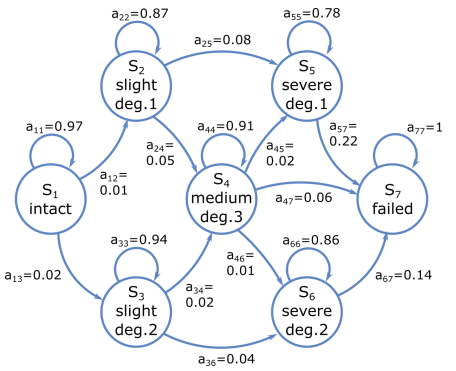
Markov Models
State-based system representation
A system can be in one of N states at any time (e.g., intact, slightly degraded, severely degraded, failed).
From the current state, it either:
Moves to another state, or
Stays in the same state.
Each state is directly observable.
The transition probabilities (numbers on arrows) show the likelihood of moving between states at each time step.
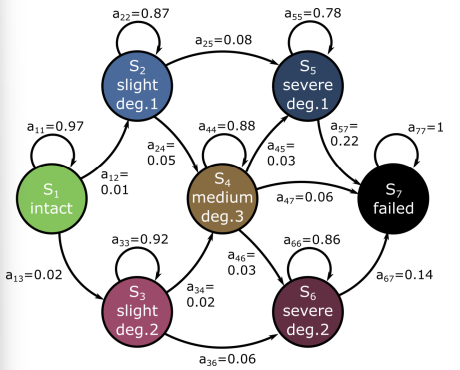
Markov Models
Deriving State transition probabilities
Shows how transition probabilities are calculated from observed data.
Example: 12 time series of state transitions are recorded.
For each state, we count how many times the system moved to other states → Then calculate percentages.
Table example: From State 1, 97% of the time it stays in State 1, 2% goes to State 2, 1% to State 3.
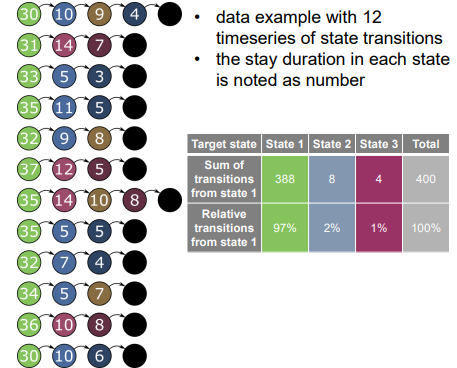
Markov Models
Predicting States into the future
Markov model tells how future states depend only on the current state (for first-order Markov).
Transition probability: aij
If you know the initial state probability, you can model the whole process.
The time spent in a state follows an exponential distribution, with formula: Pi(d)
where aii is the probability of staying in the same state.
Hidden Markov Models
In HMM, states are often not directly observed.
Only sensor measurements are available.
Observations (e.g., vibrations, temperature, running status) give clues about the hidden state.
Extension of Markov Model:
Observations are probabilistic functions of states.
True states are hidden.
Hidden Markov Models
Observation based state probability
Extension of Markov Model:
Observations are probabilistic functions of states.
True states are hidden.
HMM defined by:
A: State transition matrix (aij)
π: Initial state probabilities
B: Emission matrix (bjk = P(vk∣Sj) → Probability of observation vk given state Sj
N: Number of states
Full parameter set: λ=(A,B,π,N)
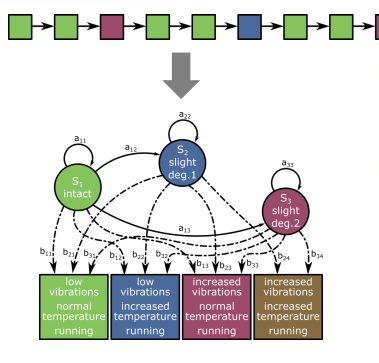
Three main training problems for HMMs:
Find P(O∣λ)P(O | \lambda)P(O∣λ): Probability of observation sequence (Forward step).
Find best state sequence QQQ for observations (Backward step).
Adjust parameters (A,B,π,N) to maximize P(O∣λ) (Baum–Welch algorithm).
Forward–Backward algorithm is the core method.
HMMs are widely used in:
Speech recognition (25%)
Human activity recognition (25%)
Bioinformatics (19%)
Musicology (9%)
Tool wear monitoring (9%)
Data processing like handwriting recognition (7%)
Network analysis (6%)
Example: Speech recognition, gesture recognition, gene sequencing, predicting melodies.
Hidden Semi Markov Models
Time-dependent presence probability
In a standard HMM, time spent in a state follows an exponential distribution:
Pi(d)
where aii is the probability of staying in the same state.In HsMM, instead of a fixed self-transition probability, we use a duration density Pi(d) that can be adjusted.
Other distributions (Gaussian, Gamma, etc.) can replace exponential.
HsMM parameters: λ=(A,B,π,D,N)
D: Duration matrix containing Pi(d) for each state.
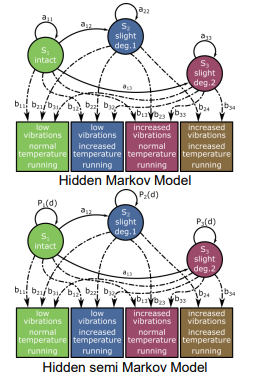

Required inputs for AG
Engineering expertise needed:
Failure modes & mechanisms knowledge.
Suitable failure indicators.
Proper sensors & acquisition setup.
Data required:
Run-to-failure data, labeled anomalies.
Scope & user analysis:
Understand user goals, connected systems, automation level.
Epistemic (structural) Uncertainty:
Epistemic uncertainty is due to a lack of knowledge about the behaviour of the system that is conceptually resolvable.
Comes from lack of knowledge about system behavior.
Can be reduced with more study and expert judgment.
Aleatoric (statistical) uncertainty:
Aleatory uncertainty arises because of natural, unpredictable variation in the performance of the system.
Comes from natural, unpredictable variations.
Cannot be reduced by expert knowledge.
Also called irreducible uncertainty.
Visualization formats
Circular bar chart:
Pro: Shows degradation and failure probability.
Con: Only shows current time, not RUL; uneven bar length may cause misperception.
Component model:
Pro: Clear mapping to components.
Con: Only shows current time; high visualization effort.
Network diagram:
Pro: Many systems/components; shows degradation & probabilities.
Con: Only normalized data; comparability issues due to radial layout.
Line chart:
Pro: Shows history and trends; can combine prognosis & diagnosis.
Con: Becomes cluttered with many systems.
Key Findings
Reliability engineering uses statistical analysis of past failure data; data analytics helps to understand real system health.
Failure rates of single components can be combined statistically to model complex systems.
Reliability engineering and PHM have differences, similarities, pros, and cons — PHM especially adds feedback through data analysis.
In Markov Models, state-to-state interactions are described by transition probabilities.
Hidden Markov Models extend this by linking states to probabilistic observations.
Machine learning & prognostics can support operators’ decision-making via automated onboard data processing.
Even with low structural uncertainty (large databases), statistical uncertainty must be considered.
PHM system requirements differ for different users and can be met via visualization techniques and specialized IT infrastructure.
